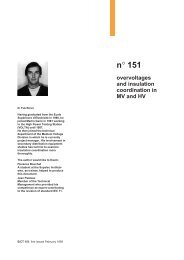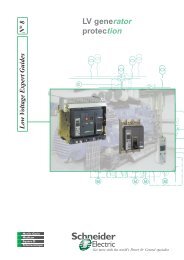sepam 20 user manual - Schneider Electric
sepam 20 user manual - Schneider Electric
sepam 20 user manual - Schneider Electric
Create successful ePaper yourself
Turn your PDF publications into a flip-book with our unique Google optimized e-Paper software.
7<br />
MT10587<br />
Commissioning Maintenance<br />
Sepam has a large number of self-tests that are<br />
carried out in the base unit and in additional<br />
modules.<br />
The purpose of the self-tests is:<br />
b To detect failures that can lead to nuisance<br />
tripping or the failure to trip when a fault occurs<br />
b To put Sepam in the fail-safe position to avoid<br />
<strong>user</strong> errors<br />
b To notify the operator that a maintenance<br />
operation is required.<br />
The "Sepam Diagnosis" screen of the SFT2841<br />
software provides access to data on the status of<br />
the base unit and optional modules.<br />
SFT2841 "Sepam Diagnosis" screen.<br />
CAUTION<br />
HAZARD OF DAMAGE TO SEPAM<br />
b Do not open the Sepam base unit.<br />
b Do not attempt to repair any components in the<br />
Sepam range, either in the base unit or an<br />
accessory.<br />
Failure to follow these instructions can cause<br />
equipment damage.<br />
7/34<br />
Shutdown of the base unit in fail-safe position<br />
The base unit goes into the fail-safe position in the following conditions:<br />
b Detection of an internal failure by the self-tests<br />
b Sensor interface connector missing (CCA630, CCA634, CCA670 or CCT640<br />
according to the type of application)<br />
b No connection of one of the 3 LPCT sensors to the CCA670 (connectors L1, L2, L3)<br />
b MES module configured but missing.<br />
See “List of self-tests which place Sepam in the fail-safe position” page 4/17.<br />
The fail-safe position is conveyed by:<br />
b ON LED on<br />
b LED on the base unit steadily on<br />
b O4 "watchdog" relay in fault position<br />
b Output relays dropped out<br />
b All protection units inhibited<br />
b Display showing fault message<br />
01<br />
b LED on DSM303 module (remote advanced UMI option) flashing.<br />
Downgraded operation<br />
The base unit is in working order (all the protection functions activated are<br />
operational) and indicates that one of the optional modules such as DSM303,<br />
MET148-2 or MSA141 is faulty or else that a module is configured but not connected.<br />
See “List of self-tests which do not place Sepam in the fail-safe position” page 4/17.<br />
According to the model, this operating mode is conveyed by:<br />
b Sepam with integrated advanced UMI (UD base):<br />
v ON LED on<br />
v LED on the base unit flashing, including when the display is out of order (off)<br />
v LED on the MET or MSA module faulty, steadily on.<br />
The display shows a partial fault message and indicates the type of fault by a code:<br />
v code 1: inter-module link fault<br />
v code 3: MET module unavailable<br />
v code 4: MSA module unavailable.<br />
b Sepam with remote advanced UMI, UX base + DSM303:<br />
v ON LED on<br />
v LED on the base unit flashing<br />
v LED on the MET or MSA module faulty, steadily on<br />
v the display indicates the type of fault by a code (same as above).<br />
Special case of faulty DSM303:<br />
v ON LED on<br />
v LED on the base unit flashing<br />
v LED on DSM303 steadily on<br />
v display off.<br />
This Sepam operating mode is also transmitted via the communication link.<br />
RTD fault<br />
Each temperature monitoring function, when activated, detects whether the<br />
temperature sensor associated with the MET148-2 module is short-circuited or<br />
disconnected.<br />
When this is the case, the alarm message "RTD FAULT" is generated.<br />
Since this alarm is common to all 8 functions, the identification of the faulty sensor or<br />
sensors is obtained by looking up the measured values:<br />
b Measurement displayed "****" if the sensor is short-circuited<br />
(T < -35°C or T < -31°F)<br />
b Measurement displayed "-****" if the sensor is disconnected<br />
(T > +<strong>20</strong>5°C or T > +401°F).<br />
Replacement and repair<br />
When Sepam or a module is considered to be faulty, have it replaced by a new<br />
product or module, since the components cannot be repaired.<br />
PCRED301005EN - 06/<strong>20</strong>08

















